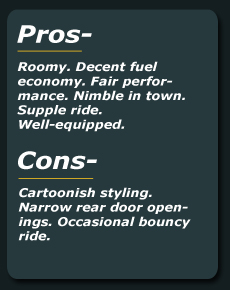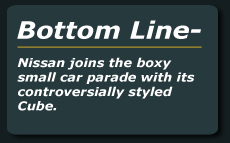2010 Nissan Cube
Prices: $13,990-$20,440
Some may laugh at the small, boxy Nissan Cube’s styling, but
that’s because they’re in the wrong country. The Cube is a
cult classic in terribly congested Japan, where small, nimble, roomy
cars shine.
The front-drive Cube isn’t very big on the outside, and items
such as its asymmetrical rear window and refrigerator-style rear hatch
draw stares. But a closer look shows a more complex and intricate
design, although I can’t agree with Nissan that it looks as if
the car has “a surprising sense of dynamic movement.”
List prices range from almost a bargain-basement $13,990 for the 1.8
Base version with a manual transmission to $20,440 for the 1.8 S Krom
Edition model with an automatic. There are the 1.8 Base, 1.8 S, 1.8 SL
and Krom Edition versions.
The Krom is actually an option package. It features unique styling
touches such as “exclusive” upper/lower front grilles, body
side sills and a rear roof spoiler. It also has a custom interior with
exclusive black and gray seats, pushbutton ignition, upgraded audio
system and hands-free phone system. There also are 16-inch
aluminum alloy wheels, rearview monitor, automatic temperature control
and 20-color interior accent lighting.
The other major option package is the SL Preferred Package, which has
push-button ignition, fog lights, color audio display, USB
connectivity, rearview monitor, satellite radio and upgraded sound
system.
The Cube is the type of car many buyers like to customize, so Nissan
offers more than 40 individual accessories. They range from 20-color
interior accent lighting to aerodynamic body kits and custom wheels.
There also are illuminated stainless kick plates and aero kits.
But don’t get the idea that every Cube model has to be loaded
with extras. In fact, all have plenty of standard equipment. Even the
1.8 Base’s standard items include air conditioning, AM/FM radio,
power windows and locks with remote entry, six air bags, anti-lock
brakes with electronic brake-force distribution and Vehicle Dynamic
Control with traction control.
This is the third-generation Cube. It joins cars such as Honda’s
Element, Scion’s xB and Kia’s Soul. It lacks the
acceleration of the Soul and xB, but is fast enough in town and does
0-60 mph in a reasonable 9.1 seconds.
Heck, that’s a little faster than even a sleek, full-size 1963
Ford Galaxie 500XL two-door fastback with a 390-cubic-inch,
300-horsepower V-8, four-barrel carburetor and dual exhausts—if
you want to return to the swinging 1960s. The Cube has a 110-cubic-inch
four-cylinder with 122 horsepower and a fraction of that Ford
V-8’s torque.
The Cube lacks dual exhausts, but its engine does have dual overhead
camshafts, four valves per cylinder and variable intake-valve
timing—advanced features totally alien to that Galaxie 500XL.
However, the Cube engine gets moderately noisy during hard
acceleration, which is to be expected when lots of revs are needed for
the best acceleration in most economy cars.
And the Cube (2,768-2,904 pounds, depending on model) weighs 766-902
pounds less than that 1963 Galaxie. A 500XL owner would be lucky to get
12-15 mpg, but the Cube’s smaller engine and lighter weight lets
it deliver an estimated 25 mpg city and 30 highway with a six-speed
manual transmission and 27 and 31 with a continuously variable
automatic (CVT) with adaptive shift control. Only regular-grade fuel is
needed.
That’s far from sensational economy for a small car, considering
that the larger, heavier 2011 Ford Mustang’s new 305-horsepower
V-6 provides an estimated 31 mpg on highways. Still, Cube owners
won’t make many stops at gas stations, and the Mustang V-6
can’t match the Cube for in-city fuel economy.
The Cube is based on Nissan’s Versa economy car platform, which
isn’t the stiffest around. The car’s supple ride is tuned
more for comfort than handling, which accounts for noticeable body sway
during quick maneuvers. Still, the Cube has a wide track and mostly
feels planted on roads. It’s nimble in town, where it likely will
spend most of its time running errands. The precise steering has decent
road feel, and the strong brakes have good pedal feel.
The “lounge” interior has wide fairly supportive front,
manually adjustable bucket seats and a sliding, reclining second row
“sofa style” theater layout bench seat. Occupants sit
fairly high.
The interior has an aircraft hanger’s aura, with a high roof and
room galore up front. Rear seat room is OK. The windshield seems about
10 miles high, all-around visibility is good. There’s a
“floating pod” instrument panel with easily read backlit
gauges and numerous cup/bottle holders. The “cube” interior
design incorporates a series of subtle “water drop”
concentric circles supposedly inspired by nature.
Large outside door handles make it easy to enter, but narrow rear door
openings hamper entry and exit.
The swing-out “refrigerator-style” hatch opens easily to
reveal a deep, but not overly long, cargo area. In some tight
situations, the swing-out feature is handy, in others it’s
obstructive. Rear seatbacks flip forward and sit flat to enlarge the
cargo area.










The hood prop is awkwardly small, but fluid filler
areas around the sideways-mounted engine are easily reached.
With the federal government clamping down hard on emissions and fuel
economy, expect to see a lot more cars with the Cube’s basic
design.







